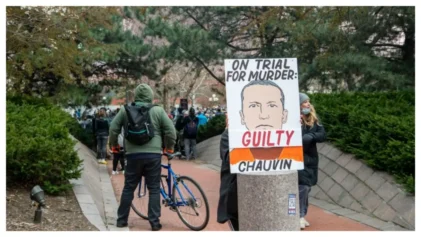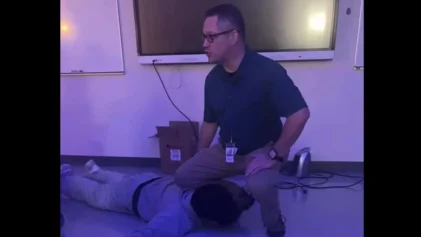Community members rebuilt a makeshift barrier around the location of George Floyd’s death at 38th Street and Chicago Avenue in south Minneapolis after city workers removed artwork, flowers, and barriers from the site early in the morning on June 3.
In the unannounced move, Minneapolis Public Works crews reopened the area to traffic after it had been blocked since Floyd’s death over a year ago on May 25.
Anger over the “pre-dawn raid” on the memorial for Floyd known informally as George Floyd Square, promoted city officials to release a statement about the surprise removal of the barricades.
“The City’s three guiding principles for the reconnection of 38th and Chicago have been community safety, racial healing and economic stability and development for Black, Indigenous, Latinx, Asian and other communities of color,” Mayor Jacob Frey, City Council Vice President Andrea Jenkins and City Council Member Alondra Cano said in a joint statement.
The statement also said that the decision to remove the barricades was made in coordination with The Agape Movement. The group had previously contracted with the city to keep watch over the memorial.
“We wanted to make the statement that the community can open this up, that the community should open it up,” Steve Floyd, an adviser with the group said. “We thought that this had naturally progressed itself to reopening.”
He added that the removal of the barriers is the first step of a three-phase plan.
“We want the square to remain as it is … they just wanted to add through traffic so they could open up and then we could begin to make this a new normal and build this community the way that it’s supposed to be.”
City spokeswoman Sarah McKenzie said the work began at about 4:30 a.m. and that the intersection was clear four hours later.
“Great care was taken to preserve as much of the memorial, artwork and artifacts as possible,” McKenzie said. “Some pieces were collected and moved away from the right of way, but the fist sculpture remains in the intersection.”
City crews reconfigured the intersection as a roundabout around a garden planter and a fist statue in the center. Floyd said the 12-foot-tall fist sculpture at the site will be permanent.
“The only thing we need to move is the dirt around the fist so that buses and fire trucks can get through, around. But everything else stays the same,” he said.
In future phases, a new design is expected for the area.
Members of Agape also showed up to make sure workers were being respectful of the memorial.
The Minneapolis Police Department said it wasn’t involved in the removal of the barriers at the memorial. Former Minneapolis Officer Derek Chauvin was convicted in April of second-degree unintentional murder, third-degree murder and second-degree manslaughter in Floyd’s death after kneeling on his neck for nearly 10 minutes.
As prosecutors seek a 30-year sentence for the former officer, his attorneys have asked the judge to sentence him to probation or a shorter prison term, according to a memorandum filed on Wednesday.
According to prosecutors, a 30-year sentence would “properly account for the profound impact of [Chauvin’s] conduct on the victim, the victim’s family, and the community.” But his defense cited the fact that Chauvin has no criminal history and suggested he could be victimized in prison. Sentencing is scheduled for June 25.
On social media, the removal of the barriers faced backlash. Marcia Howard, a teacher who had been looking after the square wrote on Instagram, “Injustice closed these streets. Only justice should open them.”
Photographer Patience Zalanga also challenged the removal of the barriers.
“This is what folks are going to say today. ‘Well, at least they didn’t get rid of ALL the things at the memorial. They still kept some parts,'” she tweeted. “But that’s not the point. What they’re trying to do is appeal to the public and have you renegotiate your stance about the memorial.”
Activists arrived and occupied the space, setting up makeshift barriers. No traffic has been able to pass through the area. Some community members have also expressed a desire for the area to remain limited to pedestrian-only access.
After Chauvin was found guilty in April, Frey recognized the significance of the location of his death, calling it “a critical and important location of racial justice and healing.”
There had been concern among city officials that the street closure was hurting businesses and making it harder for the area to be policed.
City leaders promised to open the area after the trial, but activists vowed to keep it closed until a list of 24 demands, including increased funding for social programs and affordable housing, and the removal of certain local officials, had been met.
A survey conducted earlier this year showed that community members strongly supported reopening the intersection but also wanted to maintain a permanent monument. About 4,000 surveys were distributed and 700 were returned.


